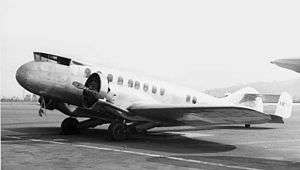Capelis XC-12
| XC-12 | |
|---|---|
 | |
| Role | Transport |
| Manufacturer | Capelis Safety Airplane Company Ltd. |
| Designer | John Younger |
| Introduction | 1933 |
| Status | Scrapped |
| Number built | 1 |
|
| |
The Capelis XC-12 was a failed 1933 aircraft design that most notably was used as a prop in the 1939 film Five Came Back with Chester Morris and Lucille Ball, the 1942 war film The Flying Tigers starring John Wayne,[1] and the 1942–1943 war film Immortal Sergeant with Henry Fonda, Thomas Mitchell, and Maureen O'Hara. The aircraft featured unusual twin horizontal tail structures supported by three vertical tail surfaces. Construction and finishing methods involved using sheet metal screws which ultimately led to the abandoning of the project.
Design and development
The original design by Socrates H. Capelis was issued U. S. patent #1,745,600 in 1930. The patent comprised a modified application with a half-span dorsal wing mounted rearward and on top of the cabin two additional engines mounted on the wings. The project was funded by local Greek restaurateurs as a promotional aircraft; it was constructed with help from University of California students.[2]
A less radical design by Dr. John E. Younger featured all-metal construction; the aircraft was built as an all-metal, low-wing, retractable gear, twin engine transport with a triple vertical tail supporting a dual (biplane arrangement) horizontal stabilizer. The wing used a large box-spar construction with corrugated skin panels. The partly retracting landing gear extended automatically when the throttle was closed.[3]
Following a 1938 incident, the XC-12 was modified at Glendale, California: The forward slanting eight-piece windshield was modified to a four piece that slanted rearward, and the passenger windows were squared off to look more like a Douglas DC-3.
Operational history
On April 15, 1938, the XC-12 suffered minor damage from a forced landing after running out of fuel while flying over Fresno, California. The main wing spar construction was bolted together, and many of the metal skin panels were attached with PK sheet metal screws rather than with permanent rivets. These tended to vibrate loose, requiring tightening or replacing every few flights, constituting a safety hazard that would later ground the aircraft. With promotional tours abandoned after the 1938 crash, the aircraft's flying career was over.
The XC-12 was then purchased by RKO in March 1939, after which the studio's insurance company permanently grounded the aircraft. Used as a full-size prop, the transport appeared only in ground roles in RKO's feature films made during World War II; flying sequences used a scale XC-12 shooting miniature. The aircraft became a RKO back lot relic, falling into worse repair during the 1940s until it was completely scrapped some time around 1950. The XC-12 miniature continued to be used in later feature films.[4]
Filmography
- Five Came Back (RKO) 1939 (aircraft and model)[5]

- Flying Blind (Paramount) 1941 (model)
- King of the Zombies (Monogram) 1941 (model and disassembled fuselage)
- Flying Tigers (Republic) 1942 (aircraft and model) John Wayne guides in a crippled XC-12 with an engine on fire, and later uses it as an improvised bomber[5]
- Invisible Agent (Universal) 1942
- Immortal Sergeant (20th Century Fox) 1942/1943 (aircraft and model)
- Adventures of the Flying Cadets (Universal) 1943 (model)
- Night Plane from Chungking (Paramount) 1943
- The Falcon in Danger (RKO) 1943 (while a Lockheed Model 10 Electra aircraft model is used for the in-flight scenes, the full-size aircraft appears as a wreck)
- Wings Over the Pacific (Monogram) 1943 (model)
- Action in Arabia (RKO) 1944
- Passport to Destiny (RKO) 1944
- Jungle Queen (serial) (Universal) 1945; re-edited into Jungle Safari a 1956 feature film
- Dick Tracy's Dilemma (RKO) 1947 The aircraft is shown somewhat dismantled in this movie, but not scrapped
- Daredevils of the Clouds (Republic) 1948 (model)
- Jungle Goddess (Lippert Pictures) 1948 (model)
- Tarzan's Magic Fountain (RKO) 1949 (model)
- On the Isle of Samoa (Columbia) 1950 (model)
- China Gate (Globe Enterprises) 1957 (model)
Specifications (XC-12)
Data from skyways
General characteristics
- Capacity: 12
- Length: 42 ft (13 m)
- Wingspan: 55 ft (17 m)
- Height: 12 ft (3.7 m)
- Wing area: 500 sq ft (46 m2)
- Airfoil: Modified USA 45
- Empty weight: 6,500 lb (2,948 kg)
- Gross weight: 9,500 lb (4,309 kg)
- Fuel capacity: 145 gal
- Powerplant: 2 × Wright Cyclone R-1750 Radial, 525 hp (391 kW) each
- Propellers: 2-bladed
Performance
- Maximum speed: 191 kn; 354 km/h (220 mph)
- Cruise speed: 165 kn; 306 km/h (190 mph)
- Stall speed: 53 kn; 98 km/h (61 mph)
- Service ceiling: 28,000 ft (8,500 m)
See also
- Aircraft of comparable role, configuration and era
References
Notes
Bibliography
- Farmer, James H. Broken Wings: Hollywood's Air Crashes. Missoula, Montana: Pictorial Histories Pub. Co., 1984. ISBN 978-0-933126-46-6.
- Gunston, Bill. World Encyclopaedia of Aircraft Manufacturers: From the Pioneers to the Present Day. Annapolis, Maryland: US Naval Institute Press, 1994. ISBN 978-1-55750-939-0.
- Hughes, Howard. When Eagles Dared: The Filmgoers' History of World War II. London: I. B. Tauris, 2012. ISBN 978-1-84885-650-9.
- Wynne, H. Hugh. The Motion Picture Stunt Pilots and Hollywood's Classic Aviation Movies. Missoula, Montana: Pictorial Histories Publishing Co., 1987. ISBN 0-933126-85-9.
External links
| Wikimedia Commons has media related to Capelis XC-12. |
- Capelis on Aerofiles
- "Light Passenger Plane Has 215-Mile Speed." Popular Science Monthly, August 1934